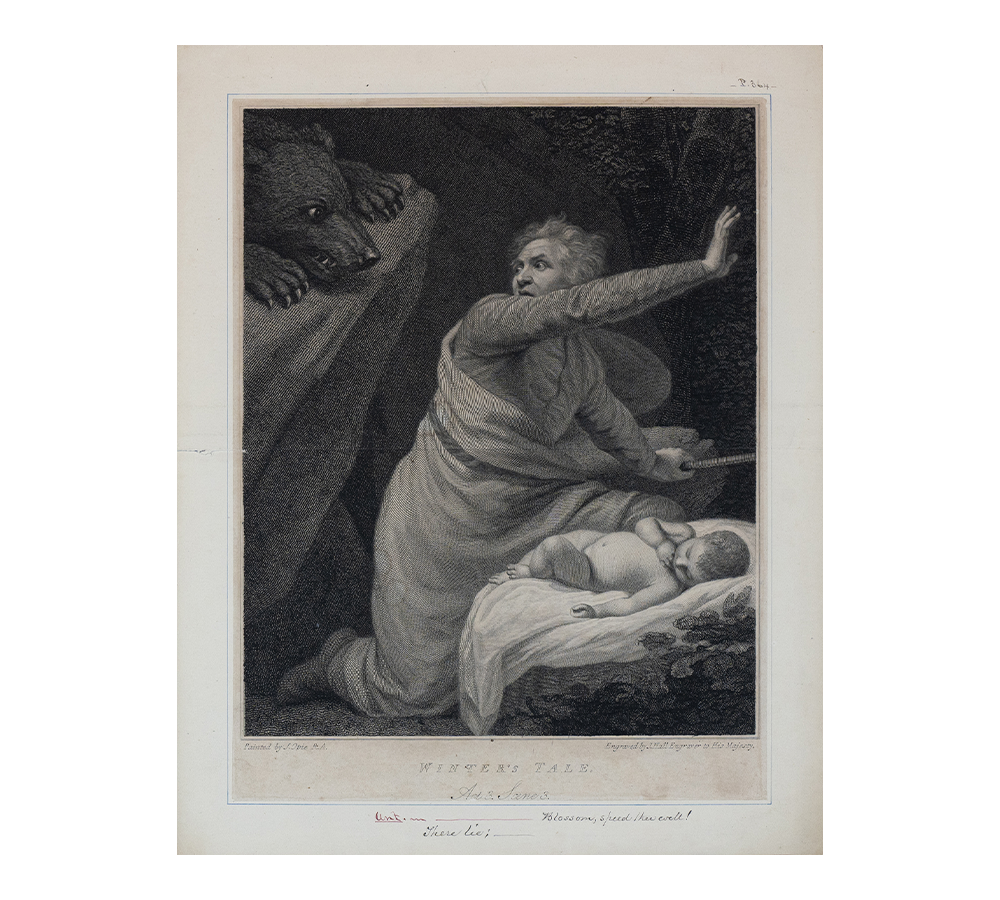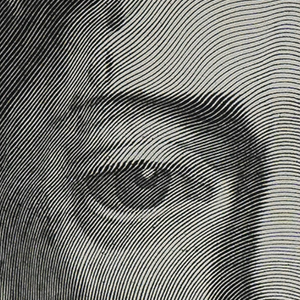Descriptions by Ariel Valdivia, with the assistance of Br. Ambrose Stewart, OSB, and Fr. Nathan Zodrow, OSB.

Sudarium of St. Veronica
Image size: 17.125″ x 12.5″ | Engraved by French artist Claude F. Mellan (1598 – 1688).
This engraving of Christ wearing the crown of thorns (Veronica’s Veil) is “composed of a single, unbroken line. It is printed on laid paper which has a fleur-de-lys watermark,” according to Pasquale Iannetti, Inc. Art Gallery, San Francisco, California. Signed and dated in the plate, 1649.


Winter’s Tale: Act 3, Scene 3
Image size: 12.75″ x 10.25″ | Painted by J. Opie R.A. | Engraved by J. Hall (1739 – 1797), Engraver to his Majesty.
Engraving of Shakespeare’s “Winter’s Tale,” Act 3, Scene 3. Antigonous has taken the infant Perdita into the forest to abandon her, but he is startled by the bear who will bring about his death. Published by Mr. Woodmason, Leadenhall Street, London, 1794.

 Tempio di Nerva
Tempio di Nerva
Image size: 5” x 7” | Made by Italian designer and engraver (dis. e inc.) Achille Parboni (1783 – 1841).
Engraving showing the ruins of the Forum of Nerva in Rome. This work came from the collection of William Bergé (d. 1830) of the family of Charles of Austria. He was the organist at the Church of St. Francis Xavier in New York City. Late 18th – early 19th century.

 Maria am Gestade (Church of Mary at the Shore)
Maria am Gestade (Church of Mary at the Shore)
Image size: 8.5″ x 6″ | Engraved by Carl Rauch (1804 – unknown) after a Jakob Meinrad Bayrer drawing.
Hand-painted steel engraving. This print shows a street view of Maria am Gestade (Mary at the Shore), one of the oldest Gothic churches in Vienna, Austria. Passersby go about their daily activities on foot or by horse, with the dominating presence of the church towering above them.

 The Rivals
The Rivals
Visible platemark 8.5″ x 6″ | Painted by R. Smirke, R.A. | Engraved by William Finden (1787 – 1852).
Etching and engraving on Chine collé (see accordion) of two elaborately dressed women standing in a richly furnished room making faces at each other as a dog and a cat play next to them. Published for the “Proprietor,” by R. Jennings, London. “The Rivals” was an illustration to page 115 of “The Keepsake,” London, October 1827.

 The Market Cross, at Winchester
The Market Cross, at Winchester
Image size: 9.25″ x 6.75″ | W.H. Bartlett (1809 – 1854) | Engraved by Edward John Roberts (1797 – 1865).
Hand-colored steel engraving from 1829 titled, “The Market Cross, at Winchester.” Citizens go about their daily chores in a cityscape dominated by the City Cross monument (also known as the Buttercross monument). London published by Longman & CS Paternoster Row. Printed by Barnett & Son for Britton’s “Picturesque Antiquities of English Cities,” Dec. 1, 1829.

 Entrance to Sorrento
Entrance to Sorrento
Image size: 17.75″ x 12″ | Drawn by James Duffield Harding. | Engraved by Samuel Fisher (1806 – 1851).
Engraving of a cityscape of Sorrento, Italy. Published by Jennings & Chaplin, 62 Cheapside, London, in Thomas Roscoe’s “The Tourist in Italy,” 1832.

 Gatehouse to the Bishop’s Palace, Norwich
Gatehouse to the Bishop’s Palace, Norwich
Image size: 9.50″ x 11.75″ | London published by Longman & Co. Paternoster Row.
Hand-colored etching. In this English cityscape, the Norwich Cathedral spire rises high into the skyline, where birds fly over the buildings. City-folk and animals (horses, dog, chickens, and a rooster) populate the foreground. Printed by Barnett & Son, 1830. Published in “Picturesque Antiquities of the English Cities,” (page 83) by John Britton, 1836.

 Portrait de Mme Herzog
Portrait de Mme Herzog
Plate marked image: 7.9″ x 6.45″ | Etching made by Achille Isidore Gilbert (1828 – 1899), after a painting by Jean Jacques Henner, which was exhibited in the Salon of 1875.
In this etching of a bust-length portrait, Madame Herzog looks out at the viewer with a confident gaze and a captivating sense of presence. She is positioned against a black background. Printed by Alfred Salmon and published in “L’Art,” 1876.

 Lady Georgiana Spencer
Lady Georgiana Spencer
Plate marks: 8.9″ x 6.9″ | Etching made by Victor Gustave Lhuillier (1844 – 1889) after a painting by Thomas Gainsborough.
Etching of Lady Georgiana Spencer, or Georgiana Cavendish, Duchess of Devonshire, at age 6. Shown half-length, a young girl faces the viewer with her hands clasped in front of her, wearing a bonnet and a frilly dress and surrounded by an ovular frame. Published in “The Portfolio,” London, 1877.

 Lavinia Bingham, Countess Spencer
Lavinia Bingham, Countess Spencer
Plate marks: 9″ x 7.4″ | Etching by Léopold Flameng (1831 – 1911), after a painting by Sir Joshua Reynolds.
Drypoint etching shows Lavinia facing left, with a largely profile view, her face turned toward the viewer. She wears a wide-brimmed hat and a white gown. This was an illustration in “The Portfolio,” London, published in April 1877.

 La Grosse Horloge, Rouen
La Grosse Horloge, Rouen
Approximate image size: 7.5″ x 5.5″ | Made by Marcel Augis.
A beautiful topographical aquatint etching, depicting the Ark of the Great Clock of Rouen. The astronomic clock lays on a Renaissance arch spanning the street Rue du Gros-Horloge, and it is flanked by a Gothic belfry from the 14th century. Marcel Augis (pseudonym of H. Dupont) was a French artist who traveled up and down the front line during the Great War, 1914 – 1918, recording the everyday life of the Allied troops. Signed in pencil by Marcel Augis in the lower right corner, 1917.

 Birch and Pine
Birch and Pine
Image size: 11″ x 7.25″ | Made by Gordon W. Gilkey (1912 – 2000).
An early etching depicting birch and pine trees by noted printmaker Gordon W. Gilkey , Oregon’s premier printmaker. Gilkey headed the Oregon State University’s art department until his retirement in 1977, after which he became curator of prints and drawings at the Portland Art Museum (1978 – 2000). Signed and dated 1935.

 Crater Lake, Oregon
Crater Lake, Oregon
Image Size: 9″ x 11.25″ | Made by Gordon W. Gilkey (1912 – 2000).
An early etching depicting Crater Lake, by noted printmaker Gordon W. Gilkey, Oregon’s premier printmaker. Gilkey headed the Oregon State University’s art department until his retirement in 1977, after which he became curator of prints and drawings at the Portland Art Museum (1978 – 2000). Signed and dated 1936.

 Battery Place – A Memory
Battery Place – A Memory
Image size: 3.5″ x 3.5″ | Made by Frederick Arnold Dirnfeld (1889 – 1962).
Etching of Battery Place, New York City, depicting a solitary tree with a wall of buildings in the background. Signature and chops, dated 1940.

 Claustro del Convento de la Merced Ciudad de Mexico
Claustro del Convento de la Merced Ciudad de Mexico
Image size: 6.5″ x 6″ | Signed “Grabart.”
Intaglio print depicting a man wearing a poncho and sombrero who stands in the cloister of the Convent of La Merced in Mexico City. Dated 1942.

 Man in Kufiyya and Agal
Man in Kufiyya and Agal
Image size: 11.25″ x 9″ | Made by Frederick Arnold Dirnfeld (1889 – 1962).
Etching depicting a man in typical mid-eastern headdress (English – coif). Signature and chops, dated 1949.

 Bali Belle
Bali Belle
Image size: 7″ x 7.25″ | Made by Frederick Arnold Dirnfeld (1889 – 1962).
Etching depicting a well-dressed Indonesian woman. Signature and chops, dated 1952.

 Solitude, Oregon
Solitude, Oregon
Image size: 3.5″ x 3.5″ | Made by Frederick Arnold Dirnfeld (1889 – 1962).
Etching depicting a solitary tree blowing in a stormy landscape. The back of the mat frame bears a signed note from the artist addressed to Abbot Damian Jentges, O.S.B., Abbot V of Mount Angel Abbey, signed and dated, “Christmas, 1958.”

 Fontana delle Tartarughe
Fontana delle Tartarughe
Image size: 7” x 5” | Made by G. B. Mirri.
Intaglio captures a view of the Fontana delle Tartarughe (The Turtle Fountain) in Piazza Mattei, Rome. Signature, 29/300, dated 1965.












 Tempio di Nerva
Tempio di Nerva
 Maria am Gestade (Church of Mary at the Shore)
Maria am Gestade (Church of Mary at the Shore)
 The Rivals
The Rivals
 The Market Cross, at Winchester
The Market Cross, at Winchester
 Entrance to Sorrento
Entrance to Sorrento
 Gatehouse to the Bishop’s Palace, Norwich
Gatehouse to the Bishop’s Palace, Norwich
 Portrait de Mme Herzog
Portrait de Mme Herzog
 Lady Georgiana Spencer
Lady Georgiana Spencer
 Lavinia Bingham, Countess Spencer
Lavinia Bingham, Countess Spencer
 La Grosse Horloge, Rouen
La Grosse Horloge, Rouen
 Birch and Pine
Birch and Pine
 Crater Lake, Oregon
Crater Lake, Oregon
 Battery Place – A Memory
Battery Place – A Memory
 Claustro del Convento de la Merced Ciudad de Mexico
Claustro del Convento de la Merced Ciudad de Mexico
 Man in Kufiyya and Agal
Man in Kufiyya and Agal
 Bali Belle
Bali Belle
 Solitude, Oregon
Solitude, Oregon
 Fontana delle Tartarughe
Fontana delle Tartarughe